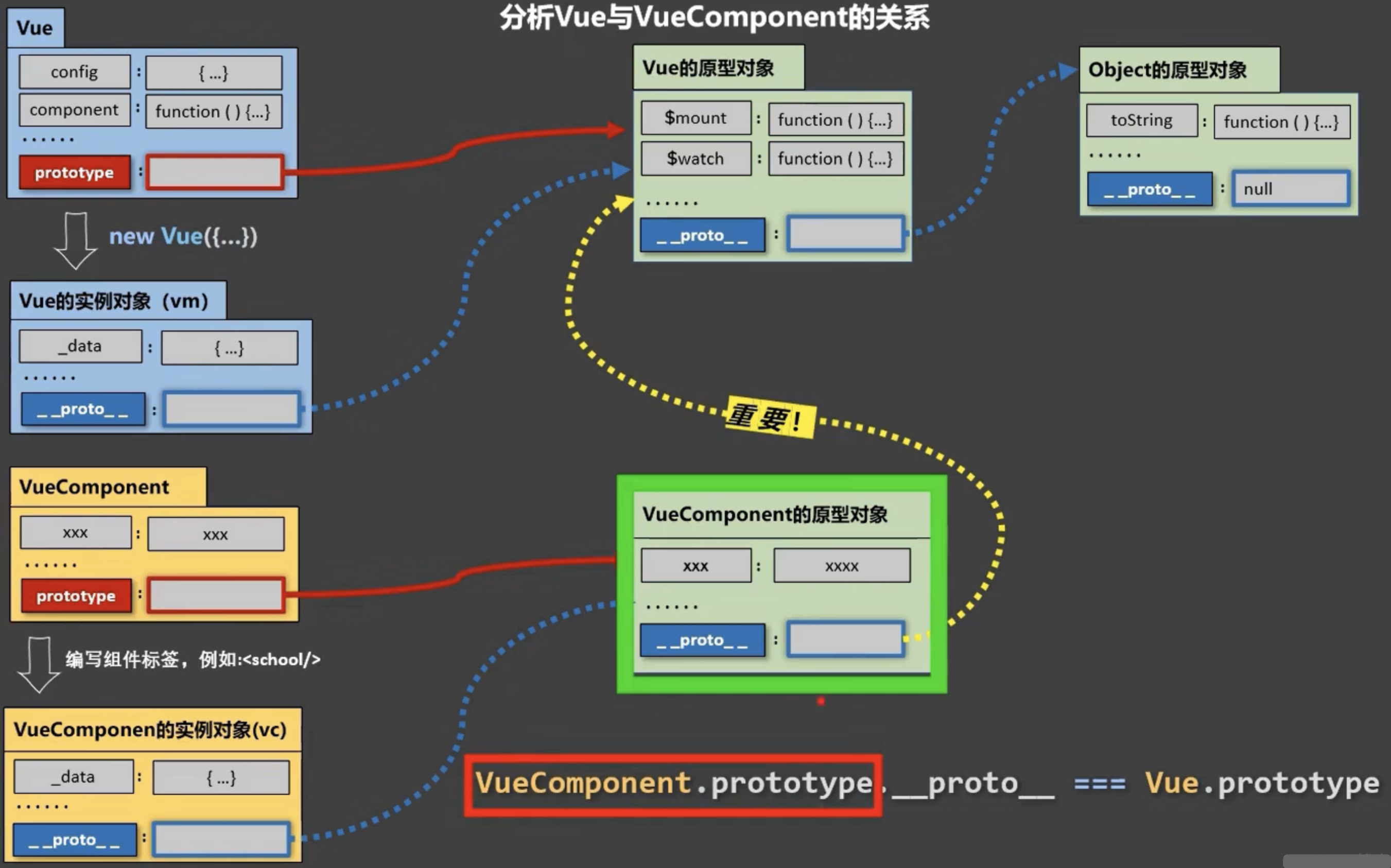【Vue笔记】Vue入门简介_组件(17)
这一篇整理了组件相关的内容。
非单文件组件
一个文件中包含 n 个组件
<!DOCTYPE html>
<html lang="en">
<head>
<meta charset="UTF-8">
<title>Vue初识</title>
<script type="text/javascript" src="./js/vue.js"></script>
</head>
<body>
<div id="root">
<!--第三步:编写组件标签-->
<xuexiao></xuexiao>
<hr>
<student></student>
</div>
<div id="root2">
<hello></hello>
</div>
<script type="text/javascript">
Vue.config.productionTip = false
//第一步:创建学校组件
const school = Vue.extend({
template: `
<div>
<h2>学校名称:{{ schoolName }}</h2>
<h2>学校地址:{{ address }}</h2>
<button @click="showName">点我提示学校名</button>
</div>
`,
//组件定义时不要写el,因为最终所有组件都要被一个vm管理,由vm决定服务于哪个容器
//el: "#root",
data() {
return {
schoolName: "三里屯小学",
address: "北京"
}
},
methods: {
showName() {
alert(this.schoolName)
}
}
})
//第一步:创建学生组件
const student = Vue.extend({
template: `
<div>
<h2>学生姓名:{{ studentName }}</h2>
<h2>学生年龄:{{ age }}</h2>
</div>
`,
data() {
return {
studentName: "张三",
age: 7
}
}
})
//第一步:创建hello组件
const hello = Vue.extend({
template: `
<div>
<h2>你好:{{ name }}</h2>
</div>
`,
data() {
return {
name: "Errol"
}
}
})
//第二步:全局注册组件
Vue.component('hello', hello)
//创建vue实例
new Vue({
el: "#root",
//第二步:注册组件(局部注册)
components: {
xuexiao: school,
student
}
})
//创建vue实例
new Vue({
el: "#root2"
})
</script>
</body>
</html>
组件使用步骤
Vue中使用组件的三大步骤
一、定义组件(创建组件)
二、注册组件
三、使用组件(写组件标签)
如何定义一个组件?
使用Vue.extend(options)创建,其中options和new Vue(options)时传入的那个options几乎一样,但也有点区别。
区别如下:
1.el不要写,为什么?
因为最终所有的组件都要经过一个 vm 的管理,由 vm 中的 el 决定服务哪个容器
2.data必须写成函数,为什么?
因为避免组件被复用时,数据存在引用关系
备注:使用template可以配置组件结构
二、如何注册组件?
1.局部注册:靠new Vue的时候传入components选项
2.全局注册:靠Vue.component(‘组件名’,组件)
总结
1.关于组件名:
一个单词组成:
第一种写法(首字母小):school
第二种写法(首字母大写):School
多个单词组成:
第一种写法(kebab-case命名):my-school
第二种写法(CamelCase命名):MySchool(需要Vue脚手架支持)
备注
(1).组件名尽可能回避HTML中已有的元素名称,例如:h2、H2都不行
(2).可以使用 name 配置项指定组件在开发者工具中呈现的名字
2.关于组件标签:
第一种写法: <school></school>
第二种写法:<school/>
备注:不用使用脚手架时,<schoo1/>会导致后续组件不能渲染
3.一个简写方式:
const school = Vue.extend(options)可简写为:const school = options
//第一步:创建学校组件
const school = {
name:'info',
template: `
<div>
<h2>学校名称:{{ schoolName }}</h2>
<h2>学校地址:{{ address }}</h2>
</div>
`,
data() {
return {
schoolName: "三里屯小学",
address: "北京"
}
}
}
组件嵌套
<!DOCTYPE html>
<html lang="en">
<head>
<meta charset="UTF-8">
<title>Vue初识</title>
<script type="text/javascript" src="./js/vue.js"></script>
</head>
<body>
<div id="root">
<app></app>
</div>
<script type="text/javascript">
Vue.config.productionTip = false
//定义学生组件
const student = Vue.extend({
template: `
<div>
<h2>学生名称:{{ name }}</h2>
<h2>学生年龄:{{ age }}</h2>
</div>
`,
data() {
return {
name: '张三',
age: 7
}
},
})
//定义学校组件
const school = Vue.extend({
template: `
<div>
<h2>学校名称:{{ schoolName }}</h2>
<h2>学校地址:{{ address }}</h2>
<student></student>
</div>
`,
data() {
return {
schoolName: '三里屯小学',
address: '北京'
}
},
components: {
student
}
})
//定义hello组件
const hello = Vue.extend({
template: `
<div>
<h2>你好{{name}}</h2>
</div>
`,
data() {
return {
name: 'Errol'
}
}
})
//创建app组件
const app = Vue.extend({
template: `
<div>
<school></school>
<hello></hello>
</div>
`,
components: {
school,
hello
}
})
new Vue({
el: '#root',
components: {
app
}
})
</script>
</body>
</html>
有一点注意,标准化开发时,建议使用 app 管理其他组件。如果不想在页面中写 app 标签,可以在 new Vue 时增加 template 标签:
<!DOCTYPE html>
<html lang="en">
<head>
......
</head>
<body>
<div id="root">
</div>
<script type="text/javascript">
Vue.config.productionTip = false
......
new Vue({
template:'<app></app>',
el: '#root',
components: {
app
}
})
</script>
</body>
</html>
VueComponent
- school 组件本质是一个名为 VueComponent 的构造函数,且不是程序员定义的,是Vue.extend 生成的
- 我们只需要写或,Vue 解析时会帮我们创建 school 组件的实例对象,即 vue 帮我们执行的:new vuecomponent(options)
- 特别注意:每次调用Vue.extend,返回的都是一个全新的VueComponent!!!
- 关于this指向
(1).组件配置中:
data 函数、methods 中的函数、watch 中的函数、computed中的函数它们的this均是VueComponent实例对象
(2).new Vue(options) 配置中: data 函数、methods 中的函数、watch 中的函数、computed 中的函数它们的 this 均是Vue实例对象 - VueComponent的实例对象,以后简称 vc(也可称之为:组件实例对象)
Vue的实例对象,以后简称vm
内置关系
一个重要的内置关系:
VueComponent. prototype.**proto** === Vue.prototype
可以用以下代码来验证
console.log(school.prototype.**proto** === Vue.prototype);
<script type="text/javascript">
Vue.config.productionTip = false
//定义一个构造函数
function Demo() {
this.a = 1
this.b = 2
}
//创建demo的一个实例对象
const d = new Demo()
console.log(Demo.prototype);//显式原型属性
console.log(d.__proto__);//隐式原型属性
console.log(Demo.prototype === d.__proto__);//隐式原型属性
//通过显式原型属性操作 原型对象,追加x属性为99
Demo.prototype.x = 99
console.log(d);
console.log(d.x);
console.log(d.__proto__.x);
</script>
2.为什么要有这个关系:让组件实例对象(vc)可以访问到 Vue 原型上的属性、方法 我们可以用之前的例子验证,写一个 school 组件,然后给 Vue 增加一个 x 属性,然后让 school 来调用
<div id="root">
<school></school>
</div>
<script type="text/javascript">
Vue.config.productionTip = false
Vue.prototype.x = 99
//第一步:创建学校组件
const school = Vue.extend({
template: `
<div>
<h2>学校名称:{{ schoolName }}</h2>
<h2>学校地址:{{ address }}</h2>
<button @click="showX">点我输出x</button>
</div>
`,
data() {
return {
schoolName: "三里屯小学",
address: "北京"
}
},
methods:{
showX(){
alert(this.x)
}
}
})
//创建vue实例
new Vue({
el: "#root",
//第二步:注册组件(局部注册)
components: {
school
}
})
</script>
欢迎大家的意见和交流
email: li_mingxie@163.com

